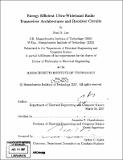Energy efficient ultra-wideband radio transceiver architectures and receiver circuits
Author(s)
Lee, Fred S. (Fred Shung-Neng), 1979-
DownloadFull printable version (9.505Mb)
Alternative title
Energy efficient UWB radio transceiver architectures and receiver circuits
Other Contributors
Massachusetts Institute of Technology. Dept. of Electrical Engineering and Computer Science.
Advisor
Anantha P. Chandrakasan.
Terms of use
Metadata
Show full item recordAbstract
Energy efficient short-range radios have become an active research area with proliferation of portable electronics. A critical specification for radio efficiency is energy/bit. The FCC has allocated the 3.1-10.6 GHz band for radios using ultra-wideband (UWB) signals. In this research, I exploit UWB signaling to develop energy efficient hardware systems for high and low data rate radios. In the high rate regime, a modular discrete prototype receiver is developed to observe pulsed UWB signals. Verification of system non-idealities upon bit-error-rate (BER) are easily observed with this system. The results are leveraged in designing a 3.1-10.6 GHz front-end in a 0.18 pm SiGe BiCMOS process, featuring an unmatched LNA and 802.11a switchable notch filter for interference mitigation. A 100 Mbps system demo is implemented to realize a wireless link. In the low rate regime, energy/bit increases because fixed power costs are less effectively amortized over fewer bits/sec. However, by using UWB PPM signaling, the receiver is duty-cycled so that energy/bit is decoupled from data rate. Through careful signaling, system, and circuit co-design, a non-coherent, 0-16.7 Mbps receiver is implemented in a 90 nm CMOS process with a 0.5 V and 0.65 V power supply. This work achieves 2.5 nJ/bit of energy efficiency over three orders of magnitude in data rate. With adjustable bandpass filters and a new relative compare demodulator, the receiver achieves 10-3 BER with -99 dBm sensitivity at 100 kbps. A first-pass acquisition algorithm is developed on an FPGA platform and a transceiver system demo is assembled using this chip.
Description
Thesis (Ph. D.)--Massachusetts Institute of Technology, Dept. of Electrical Engineering and Computer Science, 2007. Includes bibliographical references (p. 113-123).
Date issued
2007Department
Massachusetts Institute of Technology. Department of Electrical Engineering and Computer SciencePublisher
Massachusetts Institute of Technology
Keywords
Electrical Engineering and Computer Science.